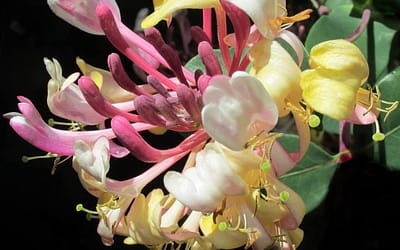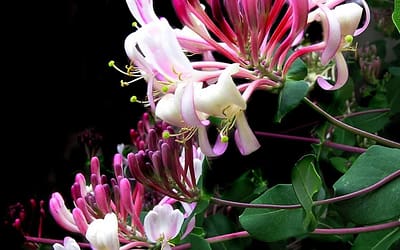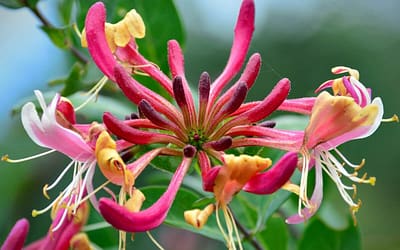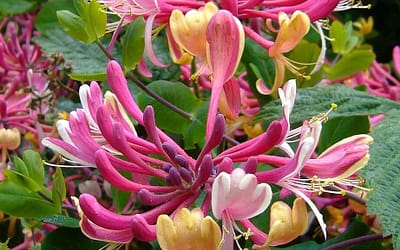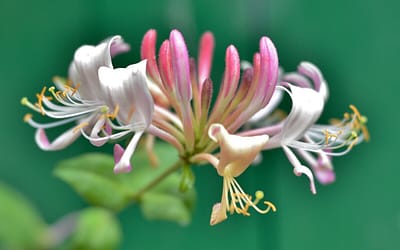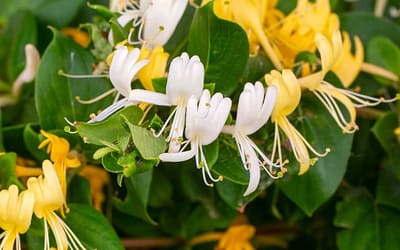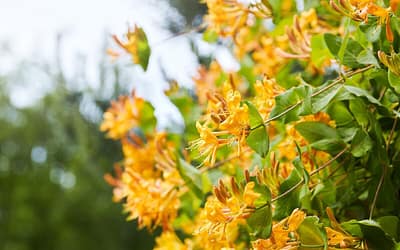Akebia quinata: The Exotic Chocolate Vine Every Gardener Should Know
Chocolate Vine
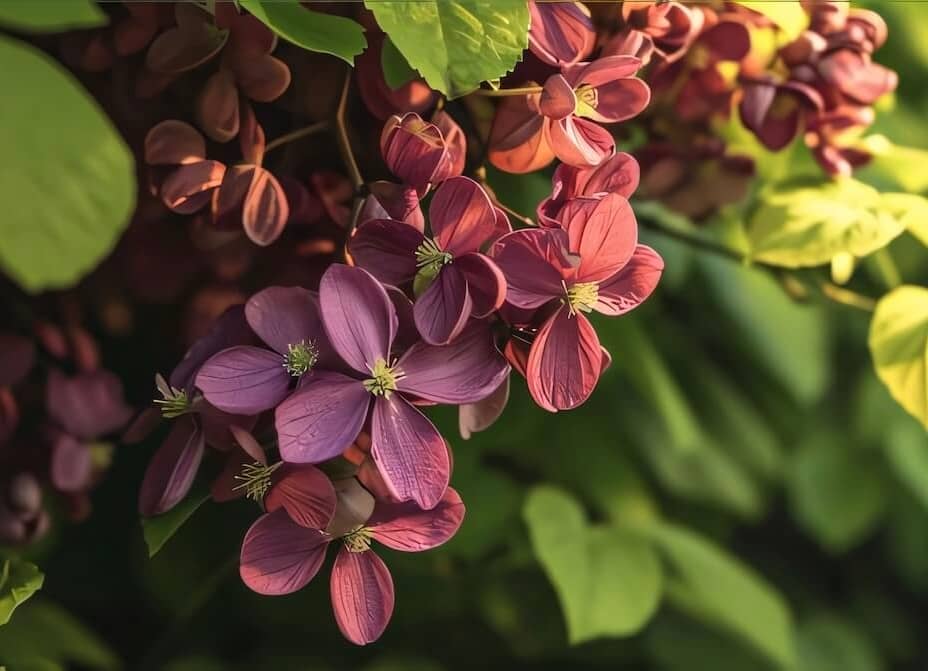
Position
- Prefers full sun for optimal flowering and fruiting but can tolerate partial shade.
Hardiness
- Hardy down to approximately -20°C (-4°F).
Soil Type
- Thrives in well-drained soil.
Soil PH
- Tolerates a range of pH levels including acid, neutral, and alkaline.
Height
- Reaches an approximate height of 8 to 12 metres (26 to 39 feet).
Seasons of Interest
- Flowering Times:
- Blooms in early to mid-spring with maroon-chocolate coloured flowers.
- Foliage:
- Primarily valued for its lush green foliage which may have a slight purple tint in colder weather.
Discover the Beauty of Akebia quinata: A Stunning Climbing Vine
Discover the intriguing charm of Akebia quinata, commonly known as the chocolate vine. With its fast-growing nature and distinctive appearance, this climbing plant adds a unique element to any garden. Whether you’re an experienced gardener or a novice, Akebia quinata promises to enhance your outdoor space with character and vitality.
Overview and Origins
Akebia quinata is native to the forests and thickets of China, Japan, and Korea. This plant is part of the Lardizabalaceae family and is known for its twining vines and attractive foliage. Its adaptation to various environments makes it a favourite among gardeners looking for resilient yet decorative climbers.
Distinctive Foliage and Flowers
One of the standout features of Akebia quinata is its striking foliage. The plant boasts compound leaves, typically five leaflets, hence the name “five-leaf akebia”. These leaves are a rich, dark green with a slight sheen, giving a lush appearance throughout the growing season.
In early spring, Akebia quinata produces clusters of small, cup-shaped flowers. These flowers are usually maroon-chocolate and have a subtle, spicy fragrance. Although not showy, the flowers are intriguing and add a unique element to the garden. The blooms can be a point of interest, drawing attention with their understated elegance.
Fruit and Edibility
In the right conditions, Akebia quinata can produce an edible fruit. The fruit appears as sausage-shaped pods, typically reaching up to 10 centimetres in length. They contain a soft, white pulp surrounded by tiny black seeds. The pulp has a mildly sweet flavour resembling a banana and melon mix. It can be enjoyed fresh or used in desserts.
Although slightly bitter, the fruit’s rind is also edible when prepared properly. It can be used in cooking, often deep-fried or stuffed, offering an exotic twist to culinary creations. However, fruiting requires both male and female plants to ensure cross-pollination.
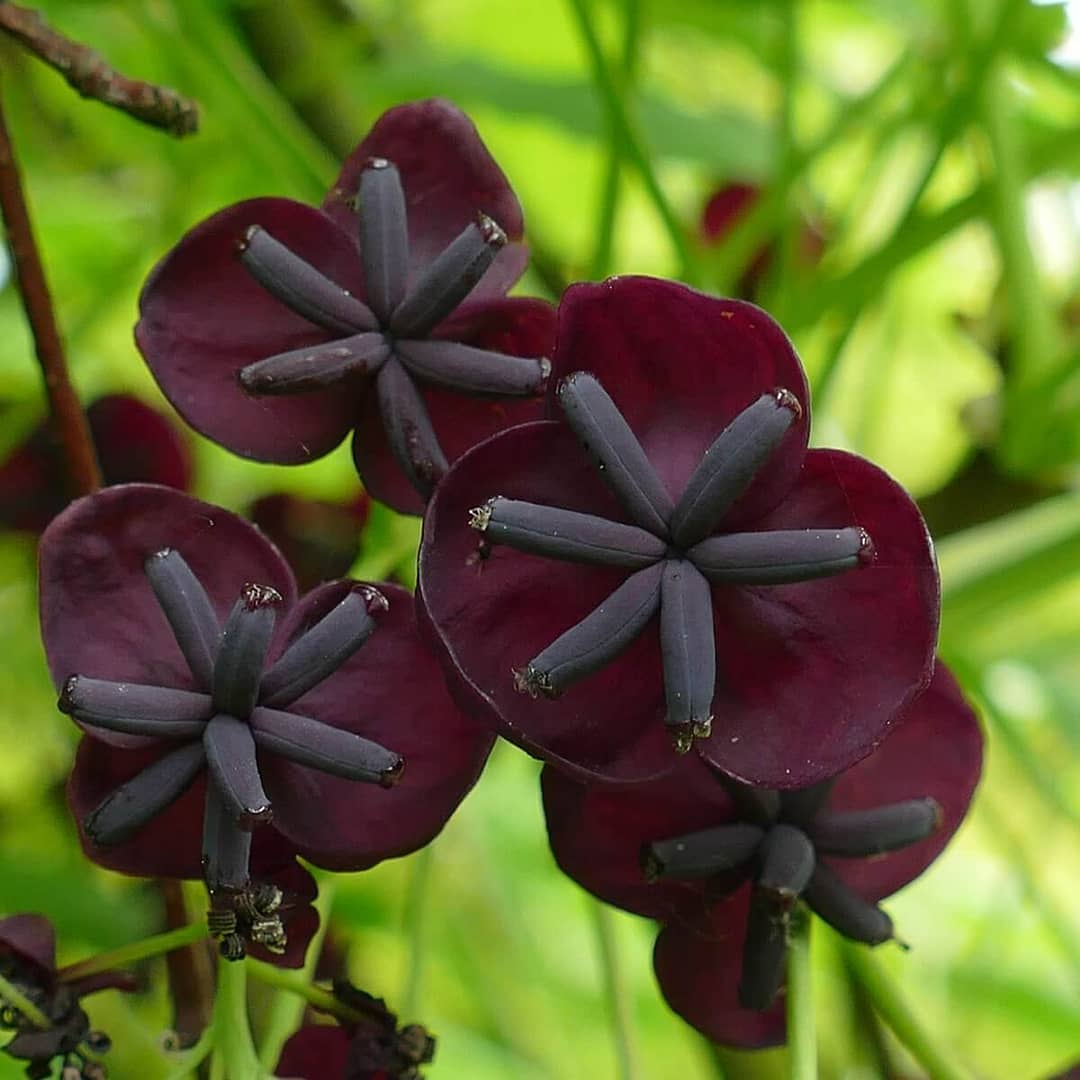
Growing Conditions
Akebia quinata is a versatile plant that thrives in various growing conditions. It can tolerate temperatures down to approximately -20°C (-4°F), making it suitable for many regions, including the UK climate. The plant prefers a sunny spot, promoting better flowering and fruiting, although it can grow well in partial shade. Ideally, choose a sheltered location to protect it from harsh winds, which can damage its delicate foliage and flowers. A position with well-drained soil is essential, as this plant does not tolerate waterlogged conditions. With these conditions met, Akebia quinata can become a vigorous and lush addition to your garden.
Ideal Soil and Watering
This plant is quite adaptable to soil types. It grows well in a range of soils, from sandy to clay. The key is ensuring the soil is well-drained to prevent waterlogging, which can harm its roots.
Regular watering is essential to keep the soil consistently moist, especially in dry periods. However, please be careful not to overwater, as this can lead to root rot. Mulching around the base of the plant can help retain moisture and reduce the need for frequent watering.
Support and Structure
Being a vigorous climber, Akebia quinata requires support to grow effectively. Provide a sturdy trellis, pergola, or fence for it to twine around. With its fast growth rate, it can quickly cover these structures, creating a lush, green canopy that can reach up to 12 metres in length.
Training the shoots as they grow will help the plant develop a strong framework. This will also ensure even coverage and prevent the plant from becoming tangled or unruly.
Pruning and Maintenance
Since Akebia quinata is a fast grower, regular pruning is necessary to keep it tidy and manageable. Pruning should be done after flowering, usually in late spring. Focus on removing dead or crossing stems and reducing the length of vigorous shoots to maintain shape.
This maintenance keeps the plant neat and encourages better flowering the following year. Please clean any fallen leaves or debris at the base since this can cause pests or diseases.
Pest and Disease Resistance
One of the appealing aspects of Akebia quinata is its resilience to pests and diseases. It is generally pest-free, making it a low-maintenance option for gardeners. However, monitoring for signs of aphids or other common garden pests is still wise. If you notice any, treat them promptly with an appropriate solution.
Ecological Impact
Due to its vigorous growth, Akebia quinata is considered invasive in some regions. Therefore, it is essential to check local guidelines before planting it in your garden. Responsible gardening practices, such as regular maintenance and preventing the plant from spreading beyond its intended area, can help mitigate ecological concerns.
Conclusion
Akebia quinata is a versatile and visually appealing climber that offers year-round interest. Its unique foliage, intriguing flowers, and potential for fruiting make it an excellent choice for gardeners seeking to add something special to their landscapes. This vigorous plant can enhance your garden with proper care and attention and provide a lush green backdrop for many years. Embrace the chocolate vine’s beauty and enjoy its benefits in your outdoor spaces. Whether covering an old fence or climbing over a pergola, Akebia quinata adds charm and function to any garden environment.
For more information on climbing plants for your garden, please click here.
Frequently Asked Questions
Q: How fast does Akebia quinata grow?
A: This vigorous climber grows rapidly, reaching 8–12 metres (26–39 feet) in height. It can spread 3–4 metres (10–13 feet) per year, making it excellent for covering large areas quickly. Regular pruning helps maintain its desired size and shape.
Q: What does the chocolate vine smell like?
A: The spring flowers release a sweet, spicy fragrance that resembles chocolate or vanilla. The scent becomes more noticeable in warm afternoons and early evenings, making it a delightful addition to seating areas.
Q: When does Akebia quinata flower?
A: The chocolate-purple flowers appear in early spring, typically March to April. These unusual blooms hang in clusters, creating a stunning display against the green foliage. The flowering period lasts several weeks.
Q: What growing conditions does it prefer?
A: Akebia quinata thrives in well-drained soil and prefers full sun to partial shade. While it adapts to most soil types, it grows best in rich, moist conditions with good drainage. Please protect it from strong winds to prevent damage to its climbing stems.
Q: How hardy is the chocolate vine?
A: This robust climber tolerates temperatures to -20°C (-4°F), making it suitable for most UK gardens. It shows excellent winter hardiness, especially in sheltered locations, and bounces back vigorously each spring, even after harsh winters.
Q: Does it produce fruit in the UK?
A: Fruit production requires warm summers and two different varieties for cross-pollination. The unusual purple fruits occasionally appear in warmer parts of the UK, growing up to 10cm long and containing edible pulp.
Q: How should I prune Akebia quinata?
A: Prune to control its size after flowering in late spring or early summer. Remove tangled or unwanted growth and cut back long shoots to maintain shape. Regular pruning prevents the vine from becoming too dense.
Q: What support does it need?
A: Install a strong trellis, pergola, or wire support before planting. The vine climbs using twining stems, so initial training helps establish good coverage. Ensure supports can handle the weight of mature growth.
Q: Is it suitable for containers?
A: Akebia quinata grows well in large containers with adequate support. Use well-draining compost and ensure regular watering, especially in dry spells. Growing it in a container helps control its vigorous spread.
Q: Does it have any pest problems?
A: Akebia quinata has excellent resistance to pests and diseases. Young growth may occasionally attract slugs, but established plants rarely face serious issues. Good air circulation helps prevent any potential problems.
Q: Where can I buy Akebia quinata?
A: Akebia quinata is widely available at garden centres and online retailers. Many UK-based plant nurseries stock it, making it easy to find for your garden.
Related Articles
Lonicera periclymenum Rhubarb and Custard
Honeysuckle Full sun to partial shade Any aspect - north, south, east, or west-facing Sheltered or exposed positions Ideal against walls, fences, or through trees Tolerates temperatures down to -20°C (-4°F) Fully hardy throughout UK Moist but well-drained soil Adapts...
Lonicera Belgica – Early Dutch Honeysuckle
Early Dutch Honeysuckle Partial shade to full sun North, south, east, or west-facing aspects Sheltered or exposed sites suitable Best against walls, fences, or climbing through trees Tolerates temperatures down to -20°C (-4°F) Fully hardy throughout UK Moist but...
Lonicera x heckrottii American Beauty
Honeysuckle Full sun to partial shade East, west, or south-facing aspects Sheltered or exposed locations suitable Fully hardy in UK climate Tolerates temperatures down to -15°C (5°F) Thrives in moist but well-drained soil Adaptable to clay and loam soils Suits acid,...
Lonicera Serotina – Late Dutch Honeysuckle
Late Dutch Honeysuckle Best in partial shade, though tolerates full sun Suitable for east, west, south, or north-facing aspects Can be grown in exposed or sheltered locations Fully hardy in UK climate Tolerates temperatures down to -20°C (-4°F) Adaptable to chalk,...
Lonicera periclymenum Strawberries and Cream
Honeysuckle Full sun to partial shade Sheltered from strong winds North, east, or west-facing walls suitable Fully hardy in UK climate Tolerates temperatures down to -15°C (5°F) Moist but well-drained Rich in organic matter Fertile loam ideal Adaptable to all soil...
Lonicera japonica Halls Prolific
Japanese Honeysuckle Full sun or partial shade South or west-facing aspect ideal Sheltered from strong winds Can grow in north-facing positions but may flower less Hardy down to -15°C (5°F) Semi-evergreen in mild winters, deciduous in harsh winters Moist but...
Lonicera x tellmanniana
Tellmann's Honeysuckle Prefers full sun or partial shade Ideal for a south-west facing position Should be sheltered from strong winds Roots enjoy cool conditions while the stems reach for sunlight Hardy down to -15°C to -10°C (5°F to 14°F) Thrives in moist but...
Lonicera periclymenum
Common Honeysuckle Prefers full sun to partial shade A sheltered spot is ideal to protect from harsh winds Can survive temperatures down to -15°C (5°F) Thrives in well-drained soil Can adapt to a range of soil types, including clay, loamy, and sandy soils Prefers...
Hedera helix Glacier
Glacier Ivy North, east, or west-facing walls Partial to full shade Sheltered from strong winds Can tolerate full sun in cooler areas Down to -15°C (5°F) Well-drained soil Medium moisture retention Rich in organic matter Clay, loam, or sandy soils all suitable Neutral...

